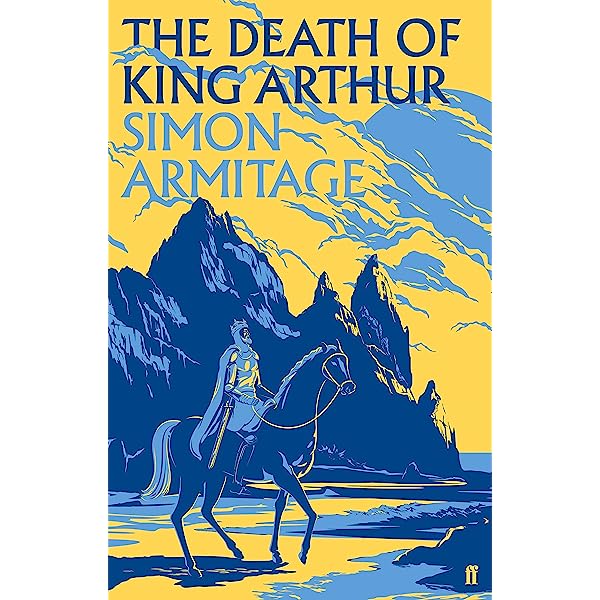Review by Hamzah Vargas
Simon Armitage’s translation of the Alliterative Morte Arthure from around 1400 covers the final adventure of the legendary king of Britain and his epic battle against Lucius, the Emperor of Rome. The author of the original is unknown and only a single copy of the original manuscript remains in the library of Lincoln Cathedral. Armitage does his job well and tries to convey the meaning of the 600-year-old text to a modern audience while retaining the alliterative pattern and poetic structure of the original. The AMA text is part of a broader tradition featuring the adventures of Arthur and the Knights of the Round Table, and in particular is believed to have influenced Sir Thomas Malory’s Le Morte Darthur of 1485.
Here, Arthur is the exemplar Commander-in-chief at the peak of his medieval empire with authority over all the British Isles, swathes of France, the Netherlands, and as far east as Denmark, Sweden, and Norway and as far south as Navarre in northern Spain. Although Arthur mostly supervises his armies and issues his commands he does engage in combat in a few scenes with the legendary Excalibur in hand. This poem is an example of the romantic medieval poetry that sought to cultivate a culture of honor and nobility into otherwise violent knights and foot soldiers. For example, Arthur’s pledge to surrendering civilians:
“No men of mine shall mistreat you, madam.
Peace I pledge you and your peerless maids,
And to children, chaste priests and to chivalrous knights”
Which certainly bears some similarity with precepts found within Islam to treat prisoners of war with dignity, therefore it is easy to wonder if the martial contact seen during the Crusades had a cultural impact on the development of chivalry. That is not to say, however, that chivalry owes its roots in the middle east – most historians will acknowledge that chivalry has its roots in Germanic culture and that the parallel movement in the Arab world, that of futuwwa, is actually coincidental. Futuwwa is a term referring to masculine youthfulness and there was an attempt by the Abbasid caliph, al-Nasir (1180-1225) to create a ‘knightly’ order that emphasized the virtues of heroic, generous young men. Another concept that arose in medieval Islamic culture was that of adab, the general rules of etiquette, sophistication, and refinement. There are some overlap but while adab rules also applied to women, for example rules on dressing well, good manners and appreciating poetry and song, the arts and the sciences, whereas futuwwa was specific to young men. However, as Brian Catlos writes in his book ‘Kingdoms of Faith’ with regards to the culture of Umayyad era Spain, the notions of adab and chivalry were similar as men of status were expected to display fearlessness and be “proud (but not vulgar), jealous (but not envious), quick both to anger and forgiveness, hospitable to strangers, loyal to friends, and generous to excess. The emerging Arabo-Islamic ideal was like chivalry on steroids”. An Arthurian example can be found in the scene where Rome’s emissaries demand his submission and tribute, yet he showers the messengers with hospitality and graciousness despite their insults.
Following the Crusades, the term futuwwa would become primarily associated with fraternal Sufi orders that were more artisanal and urban than militant but, on occasion, did participate in defending their communities. One must wonder if the concept of futuwwa should be reinvigorated in an era where many Muslim youth, see social media figures as an example of masculinity to be emulated. For the medieval European worldview, the example of Saladin following the Third Crusade became, rather ironically, an icon of chivalric virtue and he became deeply embedded in the medieval psyche in subsequent poems and folk legends, including a minor cameo here in the Death of King Arthur.
I found the political landscape the poem reveals to be quite fascinating. Although ahistorical, Rome’s allies include the Earl of Africa (today’s Tunisia) a fictional King Sextynour and other Lords of Libya, and both a King and Sultan of Syria – whom Armitage reckons to be separate characters but they confusingly perish in the same battle – along with “peerless knights of Persia and Port Jaffa”. Again, Jaffa being a strategic coastal city that witnessed several sieges during the Crusades. Rome’s Arab vassals are supported by tens of thousands of “the fiercest Saracens”, worthy opponents to cross blades with the Knights of the Round Table. Although only a minor inclusion, the two centuries since the Third Crusade has done little to fade memory of the chivalry of Saladin in this unnamed ‘Sultan of Syria’. And it is not on one occasion the Saracen “heathens” make an appearance but on several different military engagements, giving the impression that the fate of the Roman Empire was one in which the Arab world would be directly involved in.
Saladin’s cameo in the Death of King Arthur has plenty of precedent in European romance and folklore. Historical legends of the Sultan dueling Richard the Lionheart became popular in the 1250s across both England and France. In 1320 Dante’s mentioned Saladin in his Divine Comedy where he is found with a seat on the first circle of hell amongst other pagan philosophers, poets, and heroic figures. Whether the audience was French, or Germanic, or English, Saladin was seen as embodying the virtues of chivalry that European knights aspired to be and therefore it is no surprise that some spiritual ancestor is present in Arthur’s campaign against Lucius as the author is clearly drawing on existing tropes of Medieval culture.
As a historian with a strong personal interest in the history of Al-Andalus, I couldn’t help but keep an eye out for any mention of Spain. There was not many in this epic poem however in the Siege of Metz, a wealthy city in northeastern France, the Duke of Lorraine is supported by “great numbers of grim and grievous warriors from Granada”. No particular reason is given for why knights from Andalusia have arrived other than to indicate the grand scale of the conflict necessitating the appearance of the ‘who’s who’ of the medieval world; along with the simple explanation of satisfying the poem’s alliteration. Their inclusion is also a sign that news of Granada’s exploits, such as Muhammad V’s capture of Algeciras in 1369 and subsequent raids into the lands south of Sevilla and Cordoba had reached England. It is possible that his later capture of the coastal cities of Gibraltar and Ceuta in 1374 and 1384 is what allowed the Nasrid’s armies reputation to have travelled the medieval world before their inclusion in the Alliterative Morte Arthure.
One downside of the ‘Death of King Arthur’ is that it can be repetitive. Both the alliterations and the thousands dying in one gruesome battle after another battle and knights challenging each other to deadly duels. Here is an image of the glory of warfare, of empire and worldly domination. I was reminded of Surah Al-‘Adiyat in the Qur’an and it’s the imagery; “By the charging steeds that pant, and strike sparks with their hooves, who make dawn raids, raising a cloud of dust, and plunging into the midst of the enemy”. But this is subverted with a reminder of Man’s ingratitude to his Lord, and of how all deeds are accounted for in the hereafter. This is similar to the Sage’s advice to Arthur before his downfall to repent:
“I encourage you to confess all your callous crimes
Or those heinous acts will return to haunt you”
And much like the ancient Arabs of yore I suppose for the burly warriors who were the original intended audience the bloody battles would be the best part with “our” brave English knights charging again and again against the known world, even when all seems lost. As the title suggests, it all comes to an end eventually, but it doesn’t seem to argue that conquest is a pointless endeavor. King Arthur’s struggle against the Wheel of Fate turning from glory to defeat is presented at part of the path previous champions have tread. Rather, it seems to suggest that rulers should aim to be righteous and courteous in their pursuit and execution of political power along with the implication that the seed of Arthur’s downfall lies in moral decay; his endless appetite and growing abuses to the common people.
I think this book is excellent for students of late medieval Britain. Or for anyone curious to about the final adventure of one of England’s most iconic folk heroes. An example of how contentious Britain’s relationship with Europe can be and also an example of how interconnected the medieval world was and how the Arab world was always on the edge of Europe’s cultural imagination. It is also an interesting example of conveying a narrative with the tools of poetry instead of prose. At 158 pages it is not particularly long either, one could read it within a week.
Overall, I give it a 4/5. I enjoyed the story and found it an interested piece of England’s cultural heritage.


Add Comment